Category: International EM
Keywords: Zika, WHO, Public Health Emergency (PubMed Search)
Posted: 11/29/2016 by Jon Mark Hirshon, PhD, MPH, MD
(Updated: 11/30/2016)
Click here to contact Jon Mark Hirshon, PhD, MPH, MD
The World Health Organization announced on November 18th, 2016 that the Zika virus and associated consequences will no longer Public Health Emergency of International Concern. This changes the originally recommendation in February 2016.
However, Zika remains a “significant enduring public health challenge requiring intense action”. The consequences of the disease remains significant, especially for pregnant women and infants.
In early November, the CDC conducted a Clinical Outreach and Communication Activity (COCA) call on Zika in the ED: How Emergency Care Staff can Take Action. For more information, see: https://emergency.cdc.gov/coca/calls/2016/callinfo_110116.asp
https://emergency.cdc.gov/coca/calls/2016/callinfo_110116.asp
http://www.who.int/emergencies/zika-virus/en/
Category: Critical Care
Keywords: Pulmonary embolism, syncope (PubMed Search)
Posted: 11/29/2016 by Daniel Haase, MD
(Updated: 11/30/2016)
Click here to contact Daniel Haase, MD
--In this study, PE was diagnosed in ~17% of patients hospitalized for syncope (though this represents only ~4%% of patients presenting to the ED with syncope).
--Patients with PE were more likely to have tachypnea, tachycardia, relative hypotension, signs of DVT, and active cancer -- take a good history and do a good physical exam!
--Consider risk stratifying (Wells/Geneva) and/or performing a D-dimer (i.e "rule out" PE) on your syncope patients, particularly when no alternative diagnosis is apparent.
--The 17.3% prevalence of PE is in admitted patients only (in Italy). Again, 3.8% of patients presenting with syncope had PE diagnosed (though the study was not designed to study the prevalence of PE in patients presenting to the ED with syncope).
--Think about this! They only admitted 27.7% of patients with syncope!!! This suggests they only admitted sick patients with significant comorbidities.
--The vast majority of patients were ruled out by history, physical and ancillary testing and sent home (72.3%).
--Think about PE in syncope patients and do a reasonable work up (i.e. not all hospitalized PE patients need a CTA or V/Q)
Prevalence of Pulmonary Embolism among Patients Hospitalized for Syncope. Prandoni P, Lensing AW, et al. PESIT Investigators.. N Engl J Med. 2016 Oct 20;375(16):1524-1531
Category: Orthopedics
Keywords: Ankle Sprains (PubMed Search)
Posted: 11/26/2016 by Brian Corwell, MD
(Updated: 12/5/2025)
Click here to contact Brian Corwell, MD
Incidence and Cost of Ankle Sprains US Emergency Departments
In a sample of 225,114 ED patients with ankle sprains:
Lateral ankle sprains represent the vast majority of all ankle sprains (91%).
Lateral ankle sprains incur greater ED charges than medial sprains ($1008 vs. $914).
Lateral ankle sprains were more likely to have associated pain in the limb, sprain of the foot and abrasions of the hip/leg than medial sprains.
Medial sprains were more likely to include imaging.
Hospitalizations were more likely with high ankle sprains than lateral sprains.
There is a higher incidence of ankle sprains in younger patients (≤25 years) and in female patients (57%).
Shah et al., 2016. Incidence and Cost of Ankle Sprains in United States Emergency Departments. Sports Health Novemebr 2016.
Category: Pediatrics
Keywords: septic shock, cold shock, vasopressor, dopamine, epinephrine (PubMed Search)
Posted: 11/25/2016 by Mimi Lu, MD
Click here to contact Mimi Lu, MD
Which first-line vasoactive drug is the best choice for children with fluid-refractory septic shock? A prospective, randomized, blinded study of 120 children compared dopamine versus epinephrine in attempts to answer this debated question in the current guidelines for pediatric sepsis.
Bottom line: Dopamine was associated with an increased risk of death and healthcare–associated infection. Early administration of peripheral or intraosseous epinephrine was associated with increased survival in this population.
This was a small double-blind, prospective randomized controlled trial of 120 children with fluid-refractory septic shock in a PICU in Brazil. The primary outcome was to compare the effects of dopamine or epinephrine in severe sepsis on 28-day mortality; secondary outcomes were the rate of healthcare–associated infection, the need for other vasoactive drugs, and the multiple organ dysfunction score. Dopamine was associated with death (OR, 6.5; 95% CI, 1.1–37.8; p = 0.037) and healthcare–associated infection (odds ratio, 67.7; 95% CI, 5.0–910.8; p = 0.001). The use of epinephrine was associated with a survival odds ratio of 6.49. Further multicenter trials or single-center studeis are necessary to verify the reproducibiltiy of these results.
Ramaswamy KN, Singhi S, Jayashree M, Bansal A, Nallasamy K. Double-Blind Randomized Clinical Trial Comparing Dopamine and Epinephrine in Pediatric Fluid-Refractory Hypotensive Septic Shock.Pediatr Crit Care Med. 2016 Nov;17(11):e502-e512.
Category: Critical Care
Posted: 11/22/2016 by Mike Winters, MBA, MD
(Updated: 12/5/2025)
Click here to contact Mike Winters, MBA, MD
What Matters in Cardiac Arrest?
Jentzer JC, et al. Improving survival from cardiac arrest: A review of contemporary practice and challenges. Ann Emerg Med. 2016. [epub ahead of print]
Category: Visual Diagnosis
Keywords: Intussusception, pediatric, ultrasound (PubMed Search)
Posted: 11/21/2016 by Hussain Alhashem, MBBS
Click here to contact Hussain Alhashem, MBBS
A 15 months old male with no past medical history, presenting with two days of decreased oral intake and decreased urine output. The exam was notable for minimal tenderness of abdomen. During an oral fluid challenge in the ED, the patient had a single episode of bilious vomiting. The ED physician ordered an ultrasound study and the results are shown below. What is the diagnosis?
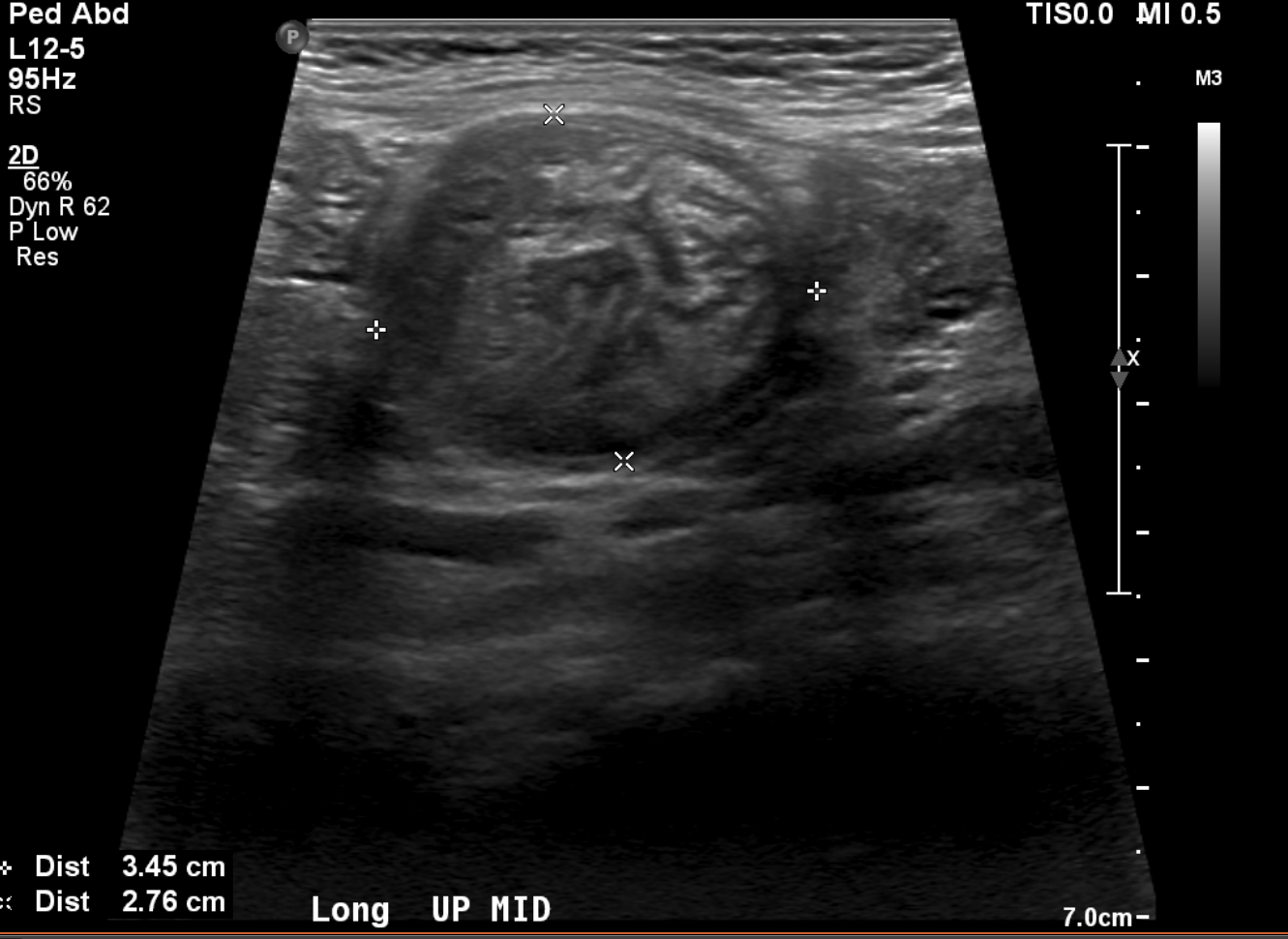
Diagnosis: Intussusception.
- The use of point of care ultrasound in the ED shortens the time to diagnosis and to definitive treatment. It has a sensitivity of 98-100% even if done by an inexperienced sonographer.
- To diagnose intussusception in the pediatric population, use the High-frequency linear probe for a better image quality. Start with scanning the right upper quadrant, and then move down to scan all four quadrants.
- Classic ultrasound findings include either a Donut-shaped or a Pseudo-kidney appearance, seen as a hypoechoic outer ring and a hyperechoic center. Other variants include; Mesenteric Crescent, where the inner loop will have a crescent hyperechoic appearance with few hypoechoic areas representing lymph nodes, or Central Limb of the Intussusceptum, where a fluid collection is present in the central limb of the intussusceptum instead of a collapsed limb.
- Utilize the US doppler to check for blood flow to the intestinal loops. Diminished blood flow correlates with irreducibility.
Del-Pozo, Gloria, et al. "Intussusception in children: current concepts in diagnosis and enema reduction." Radiographics 19.2 (1999): 299-319.
Category: Pediatrics
Keywords: Ketamine, conscience sedation, pharmacology, pediatrics (PubMed Search)
Posted: 11/18/2016 by Jenny Guyther, MD
Click here to contact Jenny Guyther, MD
Using 1.5 mg/kg or 2 mg/kg of IV ketamine led to less redosing compared to using 1 mg/kg IV.
This was a prospective, double blinded, randomized controlled trial of children 3-18 years. 125 children were included in the study. They compared 1mg/kg, 1.5 mg/kg and 2 mg/kg doses. All doses were IV. Adequate sedation was achieved with all 3 doses of ketamine, and there was no increased risk of adverse events with the higher doses. However, using 1.5mg/kg or 2 mg/kg required less redosing.
Previous studies suggested a higher risk of adverse events if the initial dose was greater than 2.5 mg/kg or the total dose was more than 5 mg/kg.
Kannikeswaran et al. Optimal dosing of intravenous ketamine for procedural sedation in children in the ED – a randomized control trial. American Journal of Emergency Medicine 24 (2016) 1347-1353.
Category: Toxicology
Keywords: heroin overdose, observation period, bystander naloxone (PubMed Search)
Posted: 11/16/2016 by Hong Kim, MD
(Updated: 11/17/2016)
Click here to contact Hong Kim, MD
Recently a review paper was published regarding the duration of observation in heroin overdose patients who received naloxone.
It made several conclusions regarding heroin overdose:
It should be pointed out that this is a review paper of limited number of articles with variable quality. Additionally, the clinical history of “heroin use” may be unreliable as fentanyl and novel synthetic opioids are also sold as “heroin.” Providers should exercise appropriate clinical judgement when caring for these patients.
The paper attempted to answer following questions
Review conclusion (8 articles): Patients were safe to release if they had normal mentation and vital signs. Mortality from recurrent heroin toxicity was 0.13% - 0.49% within 24 to 48 hours after naloxone administration.
Review conclusion (5 articles): Wide range of observation period is reported. One study showed that 1-hour observation is sufficient when patients have normal ambulation, normal vital signs and GCS of 15 after 1-hour observation.
Review conclusion (15 articles): Rate of successful reversal ranged from 83% to 100% in the literature. Bystander and first responder naloxone administration is associated with minimum risk outside of mild opioid withdrawal symptoms.
The conclusion of this review paper only applies to heroin intoxication, a short-acting opioid. However, it can be difficult to discern clinically what type of opioid is causing the clinical toxicity as “heroin” may actually be other opioids such as fentanyl or other novel synthetic opioids (e.g. U-47700).
Clin Toxicol (Phila). 2016 Nov 16:1-7. [Epub ahead of print]
Do heroin overdose patients require observation after receiving naloxone?
Willman MW1, Liss DB1, Schwarz ES1, Mullins ME1.
Category: Critical Care
Keywords: CPR, Cardiac Arrest (PubMed Search)
Posted: 11/15/2016 by Rory Spiegel, MD
(Updated: 12/5/2025)
Click here to contact Rory Spiegel, MD
It is well documented that when left to our own respiratory devices we will consistently over-ventilate patients presenting in cardiac arrest (1). A simple and effective method of preventing these overzealous tendencies is the utilization of a ventilator in place of a BVM. The ventilator is not typically used during cardiac arrest resuscitation because the high peak-pressures generated when chest compressions are being performed cause the ventilator to terminate the breath prior to the delivery of the intended tidal volume. This can easily be overcome by turning the peak-pressure alarm to its maximum setting. A number of studies have demonstrated the feasibility of this technique, most recently a cohort in published in Resuscitation by Chalkias et al (2). The 2010 European Resuscitation Council guidelines recommend a volume control mode targeting tidal volumes of 6-7 mL/kg and a respiratory rate of 10 breaths/minute (3).
Category: Orthopedics
Posted: 11/12/2016 by Brian Corwell, MD
Click here to contact Brian Corwell, MD
https://images.radiopaedia.org/images/3173801/1ee24da1a6fe907a27d2bf20481174.jpg
Young toddler presents with left lower leg pain. What is the diagnosis??
Metaphyseal Corner Fracture.
These are often very subtle findings! This fracture pattern was first seen in association with children with subdural hematomas.
https://images.radiopaedia.org/images/3173808/48ab0d13eb24f10de978b5c65af064_jumbo.jpg
It occurs due to shearing forces on the growth plate.
Most frequently seen in the distal femur, proximal humerus and tibia.
Can be bilateral.
Similar to bucket handle fracutres
Category: Neurology
Keywords: subarachnoid hemorrhage, mimic, pseudosubarachnoid hemorrhage, cerebral edema (PubMed Search)
Posted: 11/9/2016 by WanTsu Wendy Chang, MD
Click here to contact WanTsu Wendy Chang, MD
Patient found pulseless after submersion in water for 20 minutes. After ROSC, patient’s GCS was 3 and pupils are dilated and nonreactive.
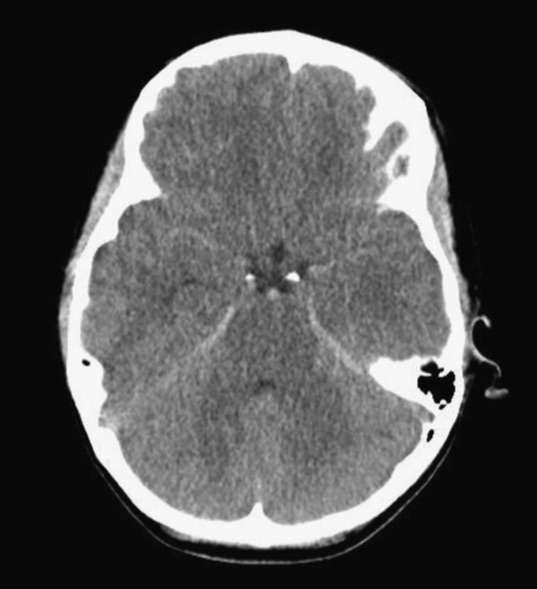
Kim JM, Eom TH. The pseudosubarachnoid hemorrhage: clinical implications of subarachnoid hemorrhage misdiagnosis. Pediatr Emerg Care. 2016 May 12. [Epub ahead of print]
Category: Critical Care
Posted: 11/8/2016 by Daniel Haase, MD
Click here to contact Daniel Haase, MD
It's Election Day in the US, so here are some interesting facts about Presidential causes of death:
George Washington likely died from epiglottitis on 12/14/1799
CLICK BELOW FOR MORE INTERESTING FACTS!
Other interesting facts:
Leading causes of death:
Category: Visual Diagnosis
Posted: 11/7/2016 by Tu Carol Nguyen, DO
Click here to contact Tu Carol Nguyen, DO
8 year-old female with no PMH who presents with concerns for "purple patches" popping up on her arm for 2-3 days. Stated that one appeared and then, the other one appeared 12 hours later. She denied any trauma whatsoever, history of easy bleeding/bruising and did feel safe at home. The rest of the review of systems was negative.
Patient said there was mild pain when the area was touched. The rest of the physical examination was normal.
What's the diagnosis? (Image below)
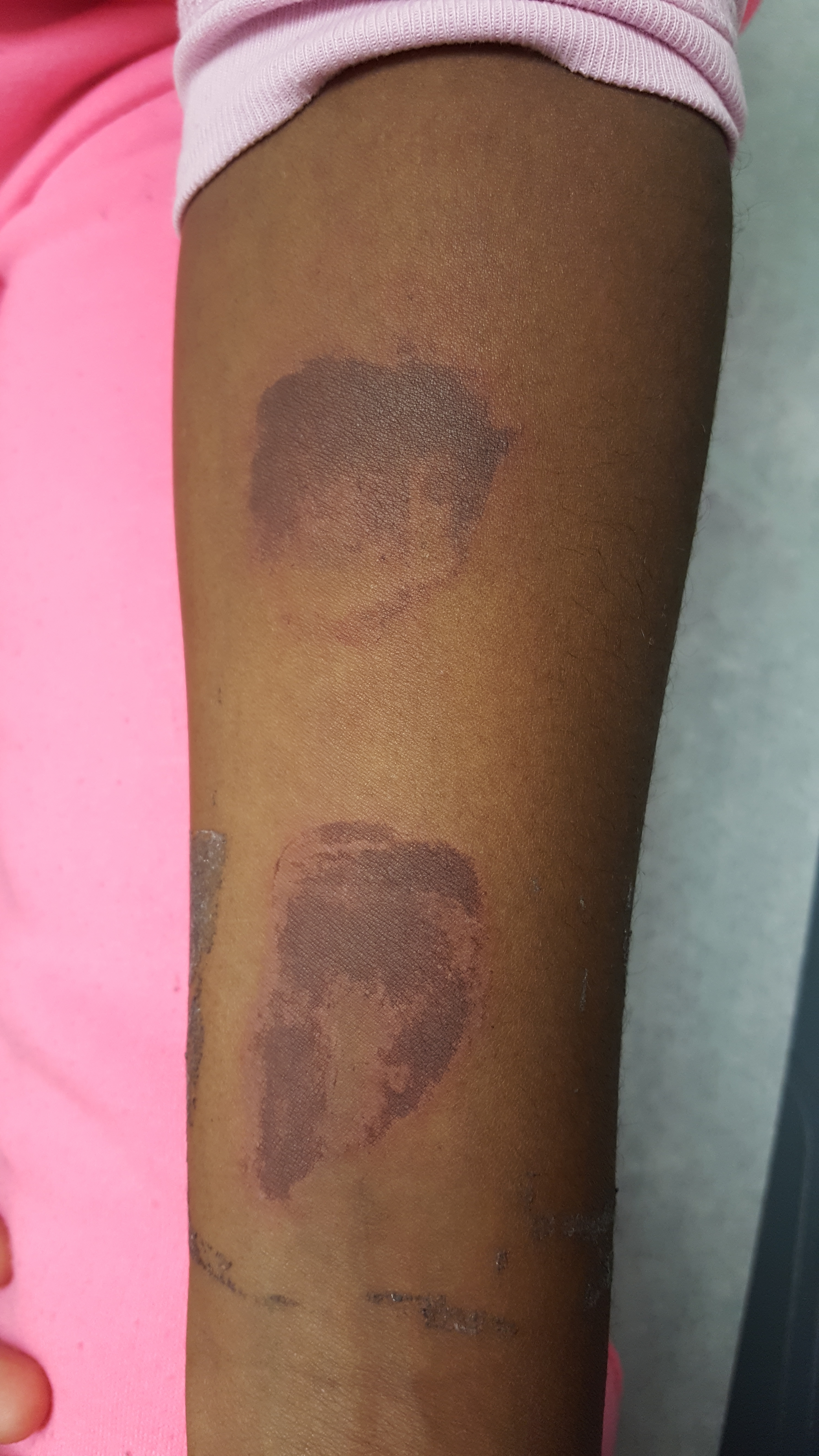
Superficial Thermal Burn
Upon further questioning, patient stated that she had been making s'mores by roasting marshmallows over an electric stove 3 days prior. The burns showed up the subsequent morning.
Take Home Points:
Previous pearls about burns:
Pediatric Burns:
Monseau AJ, Reed ZM, Langley KJ, Onks C. Sunburn, Thermal, and Chemical Injuries to the Skin. Prim Care. 2015;42(4):591-605.
"Pathophysiology of Thermal Injury." Civic Plus. 2007.
Category: Pharmacology & Therapeutics
Keywords: anticoagulation, warfarin, heparin, bridge, DVT (PubMed Search)
Posted: 11/5/2016 by Michelle Hines, PharmD
Click here to contact Michelle Hines, PharmD
Do you have a patient with renal insufficiency who is in need of an anticoagulation bridge to warfarin? Subcutaneous unfractionated heparin (UFH) as an initial dose of 333 Units/kg subcutaneously followed by a fixed dose of 250 Units/kg (actual body weight) every 12 hours may be an alternative to admission for heparin infusion with monitoring.
Practical Considerations:
Kearon C, Ginsberg JS, Julian JA, et al. Comparison of fixed-dose weight-adjusted unfractionated heparin and low-molecular-weight heparin for acute treatment of venous thromboembolism. JAMA 2006; 296:935-42. [PMID 16926353]
Morris TA, Jacobson A, Marsh JJ, et al. Pharmacokinetics of UH and LMWH are similar with respect to antithrombin activity. Thromb Res 2005; 115:45-51. [PMID 15567452]
Holbrook A, Schulman S, Witt DM, et al. Evidence-based management of anticoagulant therapy: antithrombotic therapy and prevention of thrombosis, 9th ed: American College of Chest Physicians evidence-based clinical practice guidelines. CHEST 2012; 141(2)(Suppl):e152S-e184S. [PMID 22315259]
Follow me on Twitter @mEDPharmD
Category: International EM
Keywords: Infectious Disease, ultrasound, HIV, TB (PubMed Search)
Posted: 9/29/2016 by Jon Mark Hirshon, PhD, MPH, MD
(Updated: 11/3/2016)
Click here to contact Jon Mark Hirshon, PhD, MPH, MD
As noted in a previous post, the FASH exam is the Focused Assessment with Sonography for HIV/TB. Below are typical ultrasound images of a positive FASH exam.
Peri-aortic lymph nodes- Multiple enlarged nodes, 97.1% specific for TB
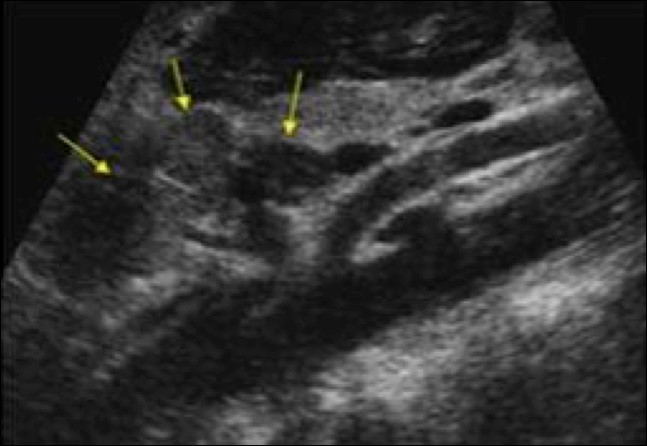
Splenic lesions – multiple ‘punched out’ lesions
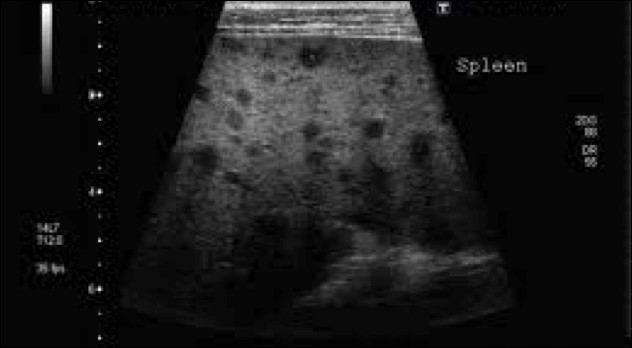
The effusions often have fibrous stranding
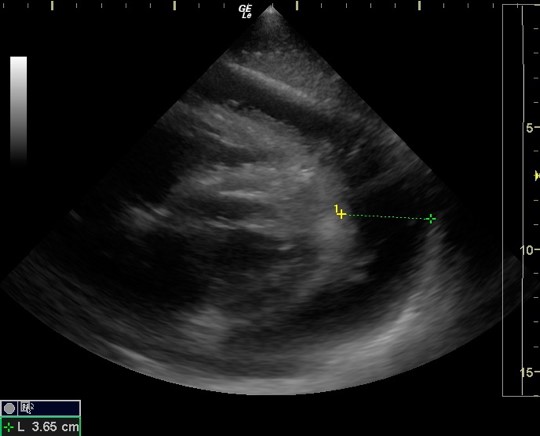
Submitted by Dr. Laura Diegelmann
Category: Critical Care
Posted: 11/1/2016 by Mike Winters, MBA, MD
Click here to contact Mike Winters, MBA, MD
Dynamic LVOT Obstruction
Category: Visual Diagnosis
Posted: 10/31/2016 by Hussain Alhashem, MBBS
Click here to contact Hussain Alhashem, MBBS
30 year old female presents with a painful finger for 1 week. Finger exam showed the following. What is the diagnosis ?
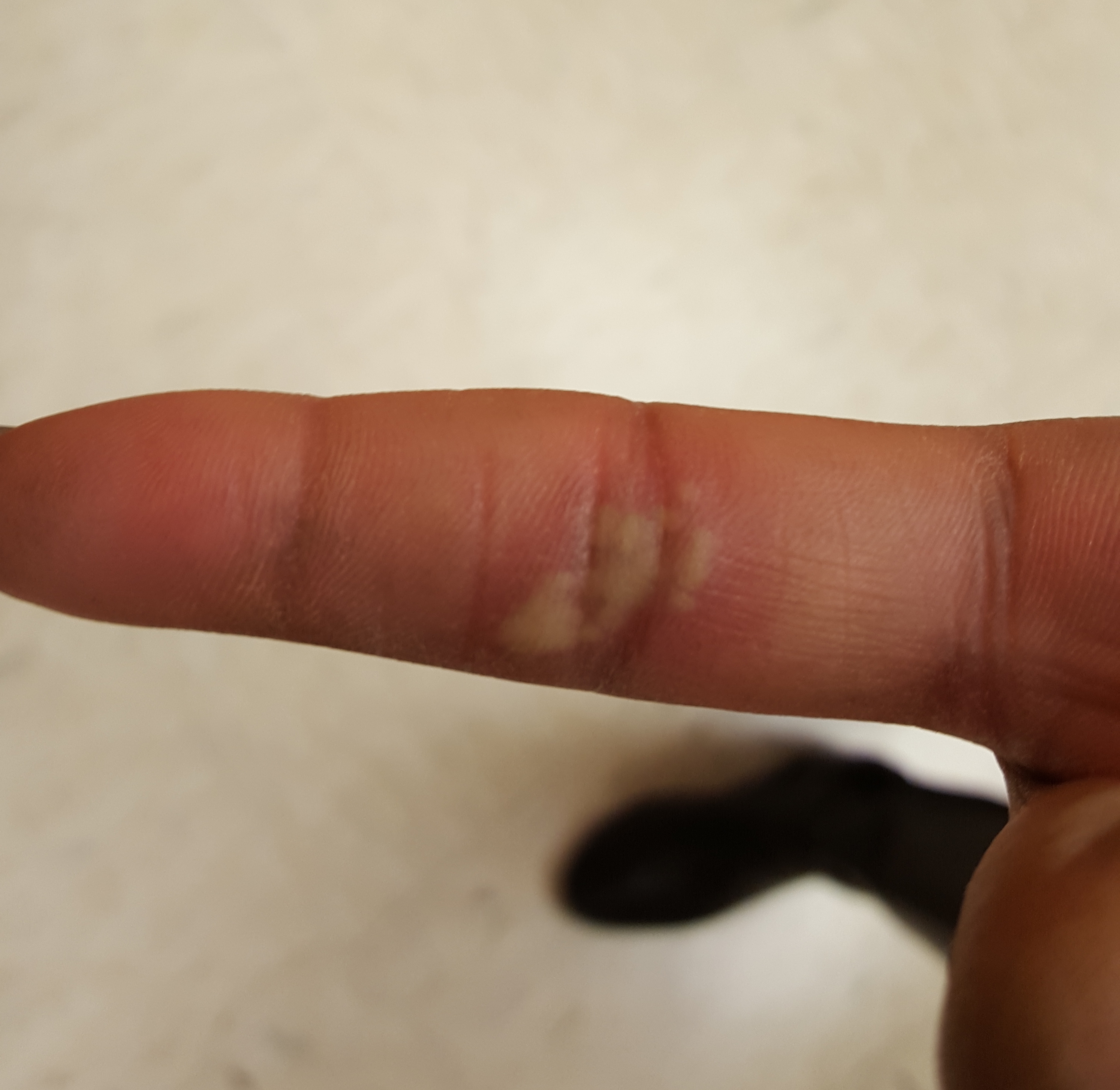
Herpetic whitlow
- It is caused by either HSV 1 or 2.
- Infection is usually transmitted by direct unprotected contact.
- Healthcare workers are at risk of contracting the infection if appropriate preventative measures were not taken when dealing with patients who have the infection.
- Diagnosis is mainly clinical. Tzank smears can be done to confirm the diagnosis if in doubt.
- Treatment with Acyclovir is thought to shorten the duration of the infection and prevent recurrence if started within 72 hours of beginning of symptoms.
- Incision of the vesicular lesion is contraindicated and can cause severe bacterial superinfection.
McDonald, Lucas S., et al. "Hand infections." The Journal of hand surgery36.8 (2011): 1403-1412.
Category: Pediatrics
Keywords: sickle cell, acute chest syndrome, pneumonia (PubMed Search)
Posted: 10/28/2016 by Mimi Lu, MD
Click here to contact Mimi Lu, MD
Typically, empiric treatment for lobar community acquire pneumonia (CAP) in immunized < 5 year olds (preschool) is amoxicillin (45mg/kg BID or 30 mg/kg TID for resistant S. pneumoniae) for outpatient and ampicillin or ceftriaxone for inpatient. Additional coverage with azithromycin is typically recommended for school age and adolescent patients (>= 5 years), but not necessarily for younger children unless there is a particular clinical suspicion for atypical pneumonia with history, xray findings, or sick contacts.
However, in sickle cell patient with suspicion for acute chest syndrome, azithromycin is recommended for all ages groups, as atypical bacteria such as Mycoplasma are a common cause of acute chest syndrome in patients of all ages with sickle cell disease even young children. In a prospective series of 598 children with acute chest syndrome, 12% of the 112 cases in children less than 5 had positive serologic testing of M. pneumoniae (9% of all cases had M. pneumoniae) (Neumayr et al, 2003).
1) Bradley et al. The Management of Community-Acquired Pneumonia in infants and children older than 3 months of age: Clinical Practice Guidelines by the Pediatric Infectious Diseases Society and the Infectious Diseases Society of America. Clin. Infect. Dis. 53:617-630 (2011)
2) Miller, S. How I treat acute chest syndrome in children with sickle cell disease. Blood 117:5297-5305 (2011)
3) Neumayr L, et al. Mycoplasma disease and acute chest syndrome in sickle cell disease. Pediatrics 1212:87-95 (2003)
Category: Toxicology
Keywords: buprenorphine exposure, pediatrics, retrospective study (PubMed Search)
Posted: 10/26/2016 by Hong Kim, MD
Click here to contact Hong Kim, MD
Recently, a retrospective study of unintentional buprenorphine/naloxone exposure among pediatric population was published. All patients were evaluated by toxicologists at the time of initial hospital presentation (or transfer) at the study center.
Bottom line
A retrospective study of single center/referral center’s toxicology consultation service.
88 patients were included. (median age: 24 months [range: 10 to 77 months]). Majority were transferred from other hospitals.
Sources of the medication were
Clinical effects
Naloxone
The median hospital stay was 22 hours (7 - 248 hours).
Category: Neurology
Keywords: contrast, epidural, multiple sclerosis (PubMed Search)
Posted: 10/26/2016 by Danya Khoujah, MBBS
Click here to contact Danya Khoujah, MBBS
Magnetic resonance imaging (MRI) is the method of choice for imaging the spine for the suspicion of non-traumatic disorder, such as multiple sclerosis (MS), transverse myelitis, epidural abscess, spinal cord infarcts, and spondylotic myelopathy (changes in the spinal cord due to disk herniation or osteophytes in degenerative joint disease).
If the differential diagnosis includes infection, neoplasm, demyelination or inflammation, then IV contrast should be administered.
Singh K, Mechtler LL and Klein JP. Imaging of Spinal Cord Disorders. Continuum 2016;22(5):1595 1612
